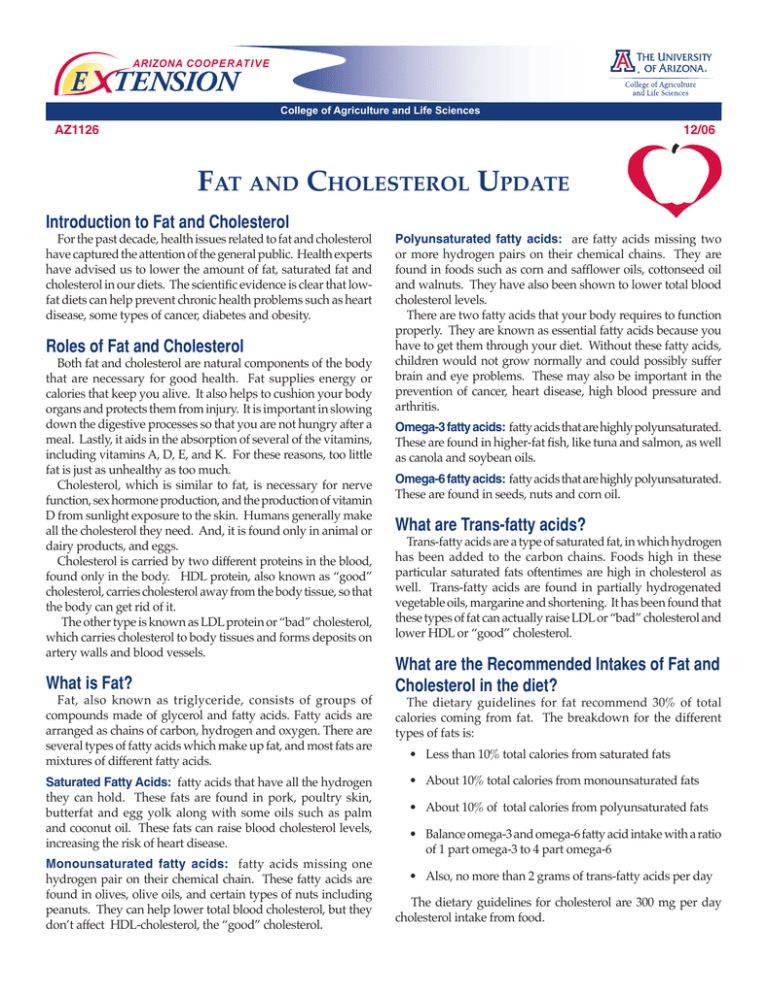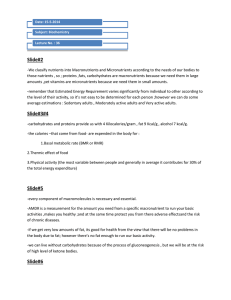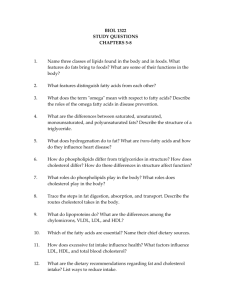F C U
advertisement

ARIZONA COOP E R AT I V E E TENSION College of Agriculture and Life Sciences AZ1126 12/06 FAT AND CHOLESTEROL UPDATE Introduction to Fat and Cholesterol For the past decade, health issues related to fat and cholesterol have captured the attention of the general public. Health experts have advised us to lower the amount of fat, saturated fat and cholesterol in our diets. The scientific evidence is clear that lowfat diets can help prevent chronic health problems such as heart disease, some types of cancer, diabetes and obesity. Roles of Fat and Cholesterol Both fat and cholesterol are natural components of the body that are necessary for good health. Fat supplies energy or calories that keep you alive. It also helps to cushion your body organs and protects them from injury. It is important in slowing down the digestive processes so that you are not hungry after a meal. Lastly, it aids in the absorption of several of the vitamins, including vitamins A, D, E, and K. For these reasons, too little fat is just as unhealthy as too much. Cholesterol, which is similar to fat, is necessary for nerve function, sex hormone production, and the production of vitamin D from sunlight exposure to the skin. Humans generally make all the cholesterol they need. And, it is found only in animal or dairy products, and eggs. Cholesterol is carried by two different proteins in the blood, found only in the body. HDL protein, also known as “good” cholesterol, carries cholesterol away from the body tissue, so that the body can get rid of it. The other type is known as LDL protein or “bad” cholesterol, which carries cholesterol to body tissues and forms deposits on artery walls and blood vessels. What is Fat? Fat, also known as triglyceride, consists of groups of compounds made of glycerol and fatty acids. Fatty acids are arranged as chains of carbon, hydrogen and oxygen. There are several types of fatty acids which make up fat, and most fats are mixtures of different fatty acids. Saturated Fatty Acids: fatty acids that have all the hydrogen they can hold. These fats are found in pork, poultry skin, butterfat and egg yolk along with some oils such as palm and coconut oil. These fats can raise blood cholesterol levels, increasing the risk of heart disease. Monounsaturated fatty acids: fatty acids missing one hydrogen pair on their chemical chain. These fatty acids are found in olives, olive oils, and certain types of nuts including peanuts. They can help lower total blood cholesterol, but they don’t affect HDL-cholesterol, the “good” cholesterol. Polyunsaturated fatty acids: are fatty acids missing two or more hydrogen pairs on their chemical chains. They are found in foods such as corn and safflower oils, cottonseed oil and walnuts. They have also been shown to lower total blood cholesterol levels. There are two fatty acids that your body requires to function properly. They are known as essential fatty acids because you have to get them through your diet. Without these fatty acids, children would not grow normally and could possibly suffer brain and eye problems. These may also be important in the prevention of cancer, heart disease, high blood pressure and arthritis. Omega-3 fatty acids: fatty acids that are highly polyunsaturated. These are found in higher-fat fish, like tuna and salmon, as well as canola and soybean oils. Omega-6 fatty acids: fatty acids that are highly polyunsaturated. These are found in seeds, nuts and corn oil. What are Trans-fatty acids? Trans-fatty acids are a type of saturated fat, in which hydrogen has been added to the carbon chains. Foods high in these particular saturated fats oftentimes are high in cholesterol as well. Trans-fatty acids are found in partially hydrogenated vegetable oils, margarine and shortening. It has been found that these types of fat can actually raise LDL or “bad” cholesterol and lower HDL or “good” cholesterol. What are the Recommended Intakes of Fat and Cholesterol in the diet? The dietary guidelines for fat recommend 30% of total calories coming from fat. The breakdown for the different types of fats is: • Less than 10% total calories from saturated fats • About 10% total calories from monounsaturated fats • About 10% of total calories from polyunsaturated fats • Balance omega-3 and omega-6 fatty acid intake with a ratio of 1 part omega-3 to 4 part omega-6 • Also, no more than 2 grams of trans-fatty acids per day The dietary guidelines for cholesterol are 300 mg per day cholesterol intake from food. How can you meet the Recommended Dietary Intakes? • Choose fish, poultry and lean cuts of meat, and remove the fat and skin before cooking • Broil, bake or roast foods instead of frying them • Cut down on highly processed meats such as hot dogs, bacon or bologna • Use only skim or low-fat dairy products • Use vegetable oils like canola or olive oil instead of butter References Anderson J. and Young L. Cholesterol and Fats. Colorado State University Cooperative Extension, August 2004. United States Department of Health and Human Services. High Blood Cholesterol: What You Need to Know. NIH Publication No. 05-3290, June 2005. United States Department of Agriculture. Fabulous Fruits… Versatile Vegetables, Dietary Guidelines for Americans. June 2003. • Eat no more than 3-4 egg yolks a week • Eat plenty of fruits, vegetables and whole grain foods • Go easy on processed or packaged high-fat foods such as cakes, cookies or doughnuts • Read food labels to determine fat and cholesterol amounts. Some food label terms are listed below: Food Label Terminology Fat-Free Less than 0..5 grams per serving size Low-fat 3 grams or less per serving Reduced or less fat At least 25% less per serving Saturated Fat-free Less than 0.5 grams saturated fat and less than 0.5 grams trans-fatty acids per serving Low saturated fat 1 gram or less per serving and not more than 15% of the calories from saturated fatty acids Reduced or less saturated fat At least 25% less per serving than the reference food Cholesterol Free Foods which contain less than 2 mg of cholesterol and 2 grams or less of saturated fat per serving Low Cholesterol Foods with less than 20 mg of cholesterol and 2 grams or less of saturated fat per serving Substitute foods that have no more than 25% of the cholesterol than the original Cholesterol Reduced kind. These products resemble the originals in flavor and taste. THE UNIVERSITY OF ARIZONA COLLEGE OF AGRICULTURE AND LIFE SCIENCES TUCSON, ARIZONA 85721 CAROL CURTIS, M.S. Research Assistant EVELYN WHITMER, M.ED. Assistant Agent, FCS/EFNEP SCOTTIE MISNER, PH.D., R.D. Associate Nutrition Specialist, Department of Nutritional Sciences This information has been reviewed by university faculty. cals.arizona.edu/pubs/health/az1126.pdf Issued in furtherance of Cooperative Extension work, acts of May 8 and June 30, 1914, in cooperation with the U.S. Department of Agriculture, James A. Christenson, Director, Cooperative Extension, College of Agriculture & Life Sciences, The University of Arizona. The University of Arizona is an equal opportunity, affirmative action institution. The University does not discriminate on the basis of race, color, religion, sex, national origin, age, disability, veteran status, or sexual orientation in its programs and activities.









